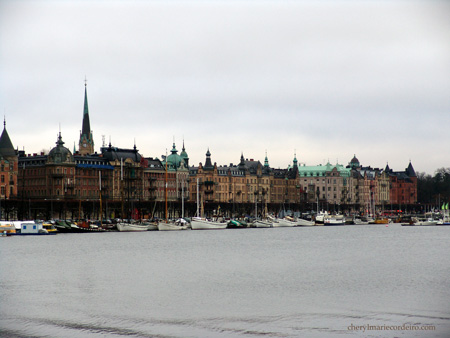
Skyline in Stockholm on a Sunday, a grey winter’s day, November 2007
We were in Stockholm over the weekend and there was variation in weather. A bright and clear blue Saturday and a grey wintry Sunday. Temperatures were around -1 deg C with rain and snow at the same time. Just the day before, the picture below of the same waterway was taken, with clear blue skies.
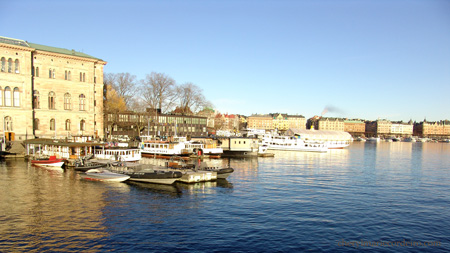
A clear blue sky on a Saturday in Stockholm, November 2007
The main attraction of our trip was a guided tour of an ongoing porcelain / ceramics exhibition put together by a friend of ours, Göte, on the various Chinese dynasty eras. The much appreciated tour was given by Göte, who is an archaeologist and curator of the Museum of Far Eastern Antiquities (Östasiaktiska Museet) in Stockholm.
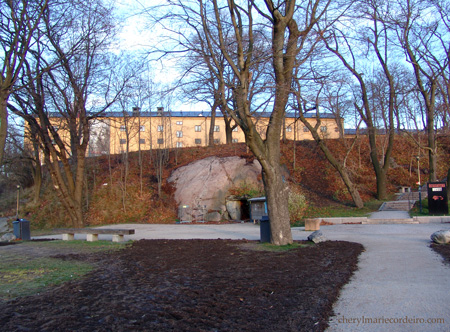
The East Asian Museum, sitting atop the hill and beyond the naked branches of the trees in this walkway
I thought the colours in the picture above typical for Sweden in autumn / winter periods, with yellows, reds, browns, grey and a sweeping azure of the occassional cloudless sky when the weather deems fit.
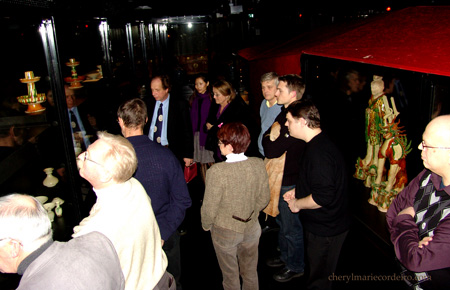
Inside the East Asian Museum in Stockholm, an exhibition on the various eras of the Chinese dynasties and their ceramic / porcelain wares.
Here is the group of us, interested and listening intently to what Göte (the one with the blue tie and standing in front of me, with the purple scarf) was explaining. We were focused, at that time, on this magnificent stone carving from the Qin dynasty, ca. 2000 years ago.
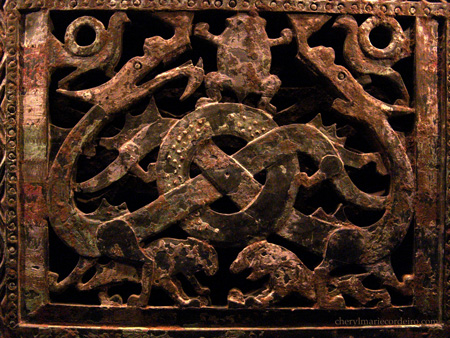
Stone carving from the Qin dynasty, ca. 2000 years ago
The above stone carving is about 1000 years apart from the Viking era, still the dragon carvings that are seen on Viking rune stones look pretty much the same as the one above. So the question is how come the Vikings picked up a 1000 year old dragon design from Asia, to be used in their rune stones? Or perhaps that this 1000 year gap in design use indicates how slowly the world moved then, compared to the zapping speed of the internet today?
We took a walk around the city on the rainy Sunday and came across many shop windows that displayed Christmas decorations, toys and lights!
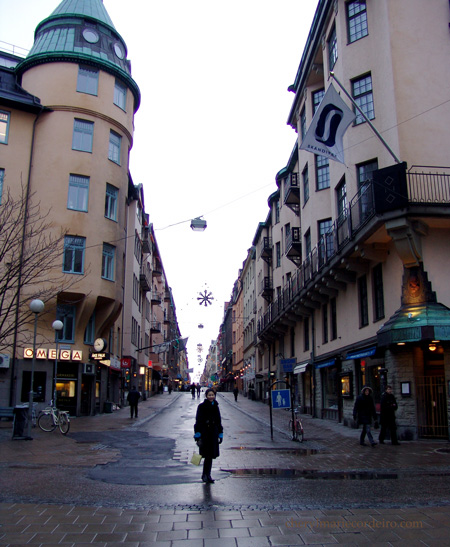
Some Christmas decorations between buildings on a road leading up to Nybrogatan, Stockholm
Hardly the Christmas light-up of Liseberg or of the city of Singapore, but nonetheless, these discreet Christmas lights that hang between the buildings lent some cheer to the grey streets of that day.
We also had the privilege to visit Stockholm’s Riddarhuset or ‘House of Nobility’ on a Sunday, which is unusual since it is closed to the general public on weekends.
A fantastic piece of architecture that is said to be the epitome of baroque architecture, The House of Nobility was erected during the period 1641-1672, with the continuous works of four architects. There is a quaint story about how the first architect, Simon de la Vallée was murdered due to a trivial argument with one of the nobles, where Simon de la Vallée ended up stabbed to death and therefore the work of the building could not be completed. Heinrich Wilhelm took over and as fate would have it, also passed away before the work could be completed. The third architect, Joost Vingboons hailed from Denmark, but due to some disagreements, packed his bags and went back to Denmark, leaving the building yet unfinished. The project was finally to be completed by de la Vallée’s own son, Jean.
Here’s the timeline on the architects’ work from Riddarhuset.se:
Simon de la Vallée (1641-1642), Heinrich Wilhelm (1645-1652), Joost Vingboons (1653-1656) and Jean de la Vallée (1656-1672). The two last mentioned can be said to have given the palace its final shape. The construction of the roof, the portals and the staircase are entirely the work of Jean de la Vallée.
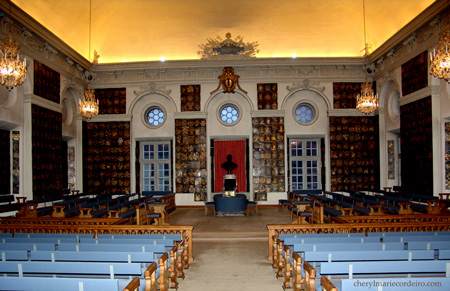
Inside the Riddarhuset, the Great Hall, with more than 2,000 shields of coat-of-arms hanging on the walls
A little more information about The Great Hall, taken from Riddarhuset.se:
The great hall of the House of Nobility was used by the aristocracy for meetings of Parliament during the Diet of the Four Estates (1668-1865). Today the Nobility gathers here for the Assembly of Nobles (every third year). At the Assembly each family that is introduced in the House of Nobility can be represented by one delegate.
Also, among others, the Academy of Sciences and the Academy of Literature celebrate their anniversaries here.
The great hall is also used as a meeting place for the different Swedish noble families as well as for chamber concerts.
On the walls of the hall are hanging the coat of arms, painted on copper plates, of noble families who have been introduced at the House of Nobility. Altogether 2.345 families are thus represented. Of these, about 600 are still alive. The coat of arms of the Counts can be found on the west wall on either side of the bust of King Gustavus II Adolphus, those of the Barons on the sides of the same wall and those of the Gentry on the remaining three walls. The coat of arms are arranged in numerical order according to the year of introduction. The coat of arms of the oldest families are placed on the south wall, sector X. The last person to be ennobled in Sweden was the explorer Sven Hedin in 1902 (sector XXXC).
On the ceiling is the allegorical painting by David Klöcker Ehrenstrahl (painted during the years 1669-1675). Mother Svea, who symbolizes Sweden, is seen in the middle, seated on a golden throne. Above her the three graces are hovering holding the Swedish coat of arms, the Three Crowns. Fama, with her trumpet, proclaims the glory of Sweden and Eterna brings eternal life to the country.
Placed at the west side of the hall is a bust of King Gustavus II Adolphus (1594-1632). There is also the remarkable chair of the land-marshals (1625), carved in ivory and ebony, depicting hunting scenes and scenes from the Holy Bible.